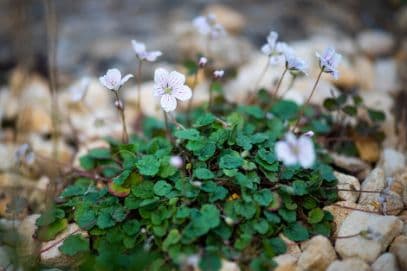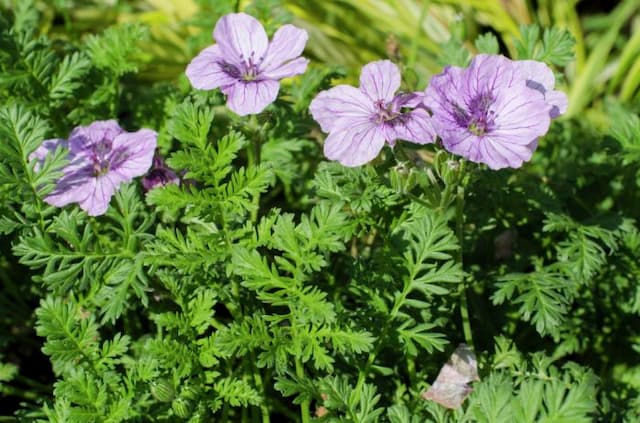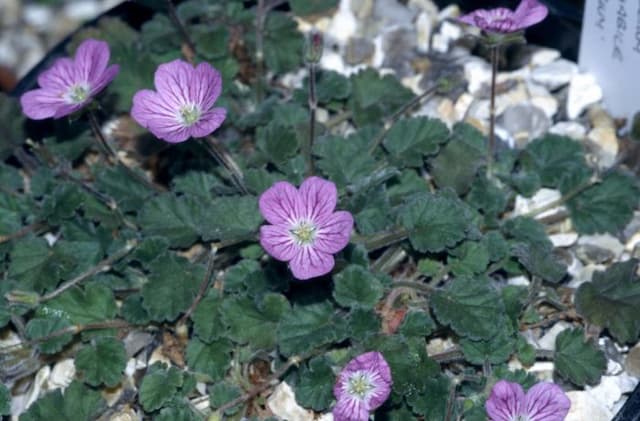Thurston's Cranesbill Geranium × oxonianum f. thurstonianum

ABOUT
This plant is characterized by an appealing mounded form graced by five-petaled flowers. The blooms present a soft and rich pink hue, often veined with deeper pink lines, delivering a delicate contrast against the petals. At the center, a cluster of prominent stamens adds an ornate touch to each flower. The foliage exhibits a deep green color, with leaves that typically have a rounded shape and may be partially lobed or deeply cut, contributing to a lush and textured appearance. Throughout the growing season, this plant presents a prolific floral display, making it a favored choice for adding a splash of color to gardens and landscapes.
About this plant
 Names
NamesSynonyms
Thurston's Cranesbill, Oxford Geranium
Common names
Geranium × oxonianum f. thurstonianum.
 Toxicity
ToxicityTo humans
Thornbill Geranium, also known as Geranium × oxonianum f. thurstonianum, is not known to be toxic to humans. Thus, it does not typically present any symptoms of poisoning when touched or ingested in small amounts. However, as with any plant, individual allergies and reactions can vary, so it is always prudent to exercise caution and avoid ingesting plants that are not commonly recognized as food.
To pets
Thornbill Geranium, which refers to Geranium × oxonianum f. thurstonianum, is generally considered non-toxic to pets. It does not contain any known toxic compounds that would cause symptoms of poisoning in pets such as dogs and cats. Nonetheless, ingestion of plant material can sometimes lead to mild gastrointestinal upset in some animals, so it's best to keep an eye on your pets and prevent them from eating ornamental plants.
 Characteristics
CharacteristicsLife cycle
Perennials
Foliage type
Deciduous
Color of leaves
Green
Flower color
Pink
Height
1-2 feet (30-60 cm)
Spread
1-2 feet (30-60 cm)
Plant type
Herb
Hardiness zones
5
Native area
Europe
Benefits
 General Benefits
General Benefits- Attracts Pollinators: Provides nectar and pollen for bees and other beneficial insects.
- Low Maintenance: Hardy and easy to care for once established in the garden.
- Drought Tolerant: Withstands periods of low water once mature, making it suitable for xeriscaping.
- Ornamental Value: Adds visual interest to gardens with its attractive foliage and flowers.
- Ground Cover: Can be used to cover bare spots and control erosion with its spreading habit.
- Wildlife Shelter: Offers shelter for small wildlife like insects and birds.
- Long Blooming: Produces flowers for an extended period, often from late spring to early fall.
 Medical Properties
Medical PropertiesThis plant is not used for medical purposes.
 Air-purifying Qualities
Air-purifying QualitiesThis plant is not specifically known for air purifying qualities.
 Other Uses
Other Uses- Geranium × oxonianum, commonly known as Hardy Geranium, can be used as a natural dye source, offering a variety of subtle hues to fabrics and yarns.
- The plant's varied foliage can provide inspiration to artists and designers, particularly for patterns in textile design or wallpaper.
- Due to its dense growth habit, Hardy Geranium can be utilized in garden design as a living mulch, suppressing weeds and retaining soil moisture.
- The flowers are edible and can be used to add color and a mild flavor to salads, desserts, or as a garnish for cocktails and beverages.
- These geraniums can be planted to provide ground stabilization on slopes or areas prone to erosion due to their spreading nature.
- Insect-repelling properties of Hardy Geranium foliage could be considered for natural pest control in gardens, though not as strong as some other plants.
- The plant can be incorporated in potpourri mixes for its foliage that retains a pleasant scent even when dried.
- When used in companion planting, Hardy Geraniums can help enhance the growth and health of nearby plants through favorable interspecies interactions.
- Hardy Geraniums can be effective at attracting pollinators like bees and butterflies, supporting local ecosystems and benefiting fruit and vegetable gardens.
- The dried leaves can be used in book pressing, providing a natural and decorative way to preserve flowers or as a craft material for creating bookmarks and similar items.
Interesting Facts
 Feng Shui
Feng ShuiThe Geranium is not used in Feng Shui practice.
 Zodiac Sign Compitability
Zodiac Sign CompitabilityThe Geranium is not used in astrology practice.
 Plant Symbolism
Plant Symbolism- Unity: The Geranium x oxonianum, commonly known as Hardy Geranium, often symbolizes unity due to its clustering blooms that stick together through various conditions.
- Comfort: The comforting look of the Hardy Geranium has led to its association with solace and the provision of a comforting presence in difficult times.
- Friendship: With its enduring and dependable nature, the Hardy Geranium is often seen as a representation of deep friendship that withstands the test of time.
- Good Health: The plant's vitality and hardiness are emblematic of good health and are commonly given with the intention of wishing someone a healthy life.
 Water
WaterThe hardy geranium, known commonly as Geranium 'Thurstonianum', requires moderate watering. Generally, you should provide about one inch of water per week, ensuring the soil stays evenly moist but not waterlogged. During the active growing season in spring and summer, increase watering to twice a week, depending on weather conditions and soil type. For container-grown plants, water until excess water flows from the drainage holes, which could be about 1 to 2 gallons depending on the size of the container. Reduce watering in the winter when the plant is dormant.
 Light
LightGeranium 'Thurstonianum' thrives best in full sun to partial shade. An ideal spot would allow for morning sunlight with some afternoon shade, especially in hotter climates, to prevent scorching of the leaves. This plant is versatile and can also grow in locations with dappled sunlight throughout the day.
 Temperature
TemperatureThe ideal temperature range for Geranium 'Thurstonianum' is between 60°F and 75°F during the day. It can tolerate temperatures down to around 30°F, but frost can be damaging, so protection might be required. This plant generally prefers cooler nighttime temperatures, which can enhance flowering and overall growth.
 Pruning
PruningPrune Geranium 'Thurstonianum' to encourage bushier growth and to remove any dead or yellowing leaves. The best time for pruning is in late winter or early spring, before new growth begins. Deadheading, or removing spent flowers, should be done regularly throughout the blooming period to promote more blooms.
 Cleaning
CleaningAs needed
 Soil
SoilThe best soil mix for Hardy Geranium (Geranium × oxonianum f. thurstonianum) should be well-draining and fertile, with a mixture of loam, peat, and coarse sand or perlite. The soil pH should be slightly acidic to neutral, ranging from about 5.8 to 7.2 for optimal growth.
 Repotting
RepottingHardy Geraniums typically do not require frequent repotting and can be left undisturbed for several years. Repotting is generally only necessary if the plant has outgrown its current container or the soil has become depleted, which might be every 3 to 4 years.
 Humidity & Misting
Humidity & MistingHardy Geraniums are adaptable to a range of humidity levels and do not require high humidity to thrive; average room humidity is usually sufficient. They are quite tolerant of outdoor conditions and do not have specific humidity requirements.
 Suitable locations
Suitable locationsIndoor
Place in bright light, ensure pot has drainage holes.
Outdoor
Plant in partial shade; water regularly; well-drained soil.
Hardiness zone
5-8 USDA
 Life cycle
Life cycleGeranium × oxonianum f. thurstonianum, commonly referred to as the Thurston's cranesbill, commences its life cycle as a seed, which upon germination in the spring, sprouts into a seedling with characteristic geranium foliage. As the seedling establishes, it grows into a vegetative plant with a robust root system and develops stems and leaves during its growth phase. During the flowering stage, typically in late spring to summer, it produces soft pink to lilac flowers that are hermaphroditic, containing both male and female reproductive structures to facilitate pollination. After successful pollination, usually by insects, the plant sets seeds encased in a distinctive beak-like fruit. Once matured, these seeds disperse, often by the beak-like fruit mechanism that flings seeds away from the parent plant. In the dormant stage, during the colder months, the plant's above-ground growth dies back, with the roots remaining alive to regrow in the next favorable season.
 Propogation
PropogationPropogation time
Spring-early summer
Geranium × oxonianum f. thurstonianum, commonly known as the Thurston's Crane's-bill, is frequently propagated by division. This method is most successful when carried out in the spring or autumn. To propagate by division, a gardener would carefully dig around the plant to lift it from the soil, ensuring they retain as much of the root system as possible. The clump is then gently pried apart into several smaller sections, each with a portion of the root system and several shoots. These divisions are then replanted at the same depth they were originally growing, spaced approximately 12 inches (about 30 centimeters) apart to allow for ample growth. The soil should be well-draining and the divisions kept well-watered until they are established.




![Cranesbill [Blue Sunrise]](/_next/image?url=https%3A%2F%2Fplants-admin.emdemapps.com%2Fimages%2Fplants%2F%2Fimages%2F604b638d45948.png&w=640&q=75)




